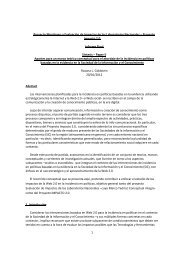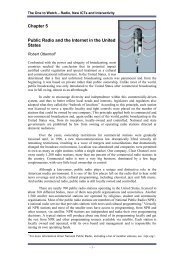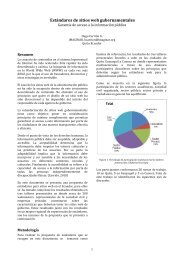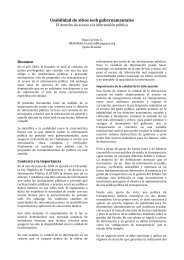<strong>New</strong> models to serve <strong>and</strong> empower the poor■■■■or firms within the community served. Such shareholders may include only a smallminority of the total catchment community, <strong>and</strong> the voting power of individualshareholders may vary greatly;User cooperatives, in which the users are also shareholders, in general each havingthe same level of voting power;<strong>Community</strong> cooperatives, in which all members of for instance a village, irrespectiveof whether they are actual or potential users, may be members, <strong>and</strong> in which allhave equal voting rights; 1Worker cooperatives, in which the workers are also the enterprise’s owners <strong>and</strong>managers;A community owned element in the context of a larger consortium that might includepublic <strong>and</strong> private interests, <strong>and</strong> non-profit <strong>and</strong> for-profit components.In terms of management <strong>and</strong> member participation, a number of approaches are alsoadopted. While these all involve a certain degree of community control, formal ownershipmay not be required:■■■■■Management can be similar to that of conventional firms, for instance with a boardof directors appointed by elected officials, <strong>and</strong> hired professional staff;Advisory committees <strong>and</strong> mechanisms can be in place to ensure that the voice of thecommunity is at least acknowledged <strong>and</strong> heard;Effective community control can be exerted without ownership per se, through a legalm<strong>and</strong>ate to decide with the owners (public or private) on key parameters of the initiative,such as tariffs, services, reach, etc.Management can be elected, by means of direct <strong>and</strong> equal participation of all the communitymembers;<strong>Community</strong> members can directly participate in the activities of the enterprise,through voluntary or non-voluntary work.<strong>Community</strong>-driven initiatives <strong>and</strong> cooperatives have emerged in all sectors <strong>and</strong> in allregions of the world. The formal cooperative model <strong>and</strong> the empowerment model ofownership suggest a spread of capabilities, though in practice they often coexist as componentsof a single model.The Cooperative Model of OwnershipThe cooperative model has seen great success. Agricultural cooperatives have proliferatedin many rural societies, evolving into major industries in many developed countries. 2 Inless developed countries, notably in Latin America, cooperatives have been one of the mainvehicles for building <strong>and</strong> maintaining local water <strong>and</strong> electricity infrastructures <strong>and</strong> servicesin rural areas.Different phases in cooperative development are identified in a recent ILO report (Birchall2003: Chapter 1). The most recent emerged during the 1970s, at which time a hierarchicallyorganised cooperative movement enjoyed significant, but top-down, government sup-20
<strong>Community</strong>-<strong>based</strong> <strong>Networks</strong> <strong>and</strong> <strong>Innovative</strong> <strong>Technologies</strong>port <strong>and</strong> infrastructure in many countries, serving also as a key delivery vehicle for governmentservices. Although these benefited middle-level rural populations, there was awidespread feeling that cooperatives were failing to reach the poor. As reregulation <strong>and</strong>privatisation weakened much of their supporting infrastructure, a new more autonomous<strong>and</strong> member-driven paradigm came to the fore in the 1980s. In line with this, the newcooperatives began to build upwards from members’ <strong>and</strong> community needs <strong>and</strong> reinvigoratedtheir structures, recognising self-sufficiency <strong>and</strong> long-term sustainability as key goals.For external aid, the emphasis was on human resource development, supportive legislation,fair taxation, <strong>and</strong> so forth. Any subsidies would be transparent, usually temporary<strong>and</strong> goal-directed. The key was to return control of the cooperatives to members, recallingthe founding principles of autonomous, democratic <strong>and</strong> open organisation.In 2003 UN Secretary General Kofi Annan acknowledging the role of cooperatives in povertyreduction <strong>and</strong> in supporting the Millennium Development Goals: 3The adoption of those goals expressed the resolve of the international community to free allpeople from the abject <strong>and</strong> dehumanizing conditions of extreme poverty <strong>and</strong> hunger. Asmodels of self-help <strong>and</strong> solidarity, cooperatives underst<strong>and</strong> better than most that, while suchhigh-level political support is welcome <strong>and</strong> necessary, progress does not happen by itself, butrather through sustained individual <strong>and</strong> collective action.Annan noted that the UN General Assembly in 2001 adopted guidelines to help governmentsto create legislative <strong>and</strong> policy environments conducive to the establishment of cooperatives,<strong>and</strong> to help cooperatives themselves advocate <strong>and</strong> negotiate these very changes. 4 The UNCommittee for the Promotion <strong>and</strong> Advancement of Cooperatives (COPAS), convenesthe UN Secretariat, a number of its agencies <strong>and</strong> major NGOs to exchange information,undertake research <strong>and</strong> promote cooperative in their practice. 5 The FAO <strong>and</strong> ILO are particularlyactive. Such cooperatives exist across all sectors but are particularly relevant todomestic infrastructure such as electricity <strong>and</strong> water.The Empowerment Model of OwnershipOften less formally concerned with legal title than the cooperative model, the empowermentmodel focuses on the self-determination <strong>and</strong> development of marginalised <strong>and</strong>disadvantaged communities.During the late 1970s <strong>and</strong> early 1980s development thinking underwent a profoundtransformation in response to a perceived widespread failure of imposed top-down developmentsolutions. Participatory approaches came to the fore, in which the active involvementof local populations, the ‘target-beneficiaries’, at all stages from conception, to design, todeployment <strong>and</strong> evaluation, became an essential feature of most development activity. Thelesson took root <strong>and</strong> still holds true across development activities, from the World Bank 6<strong>and</strong> UNDP through to bilateral programmes <strong>and</strong> donor NGOs. The aim is in large partto instil a sense of ownership within the community, a factor understood as a central featureof long-term sustainability. A review in 2000 of the concept of ownership in aidstructures concluded that more or better ownership by local stakeholders is crucial to therelevance, effectiveness, efficiency, impact, <strong>and</strong> sustainability of development activities,<strong>and</strong> is something that all should aspire to <strong>and</strong> design for (Molund 2000).21
















